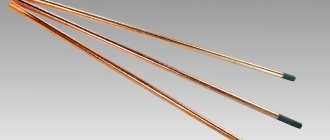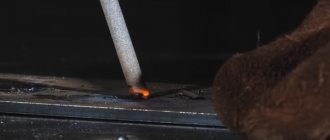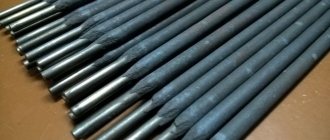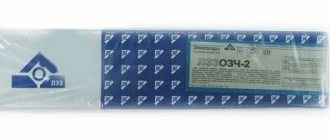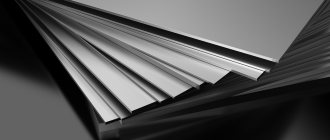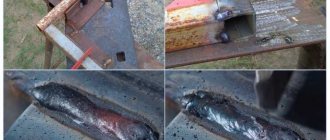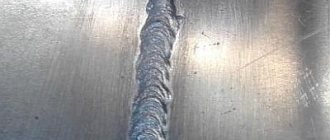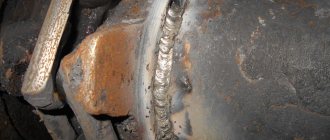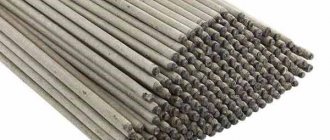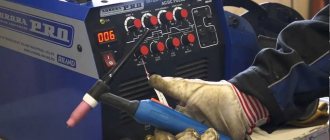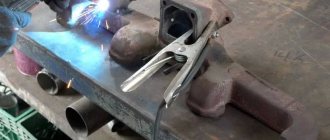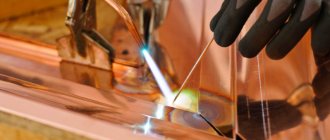An inverter type welding machine is usually used for household work. This equipment has a large list of advantages. Therefore, novice performers often have a question about which electrodes are suitable for inverter welding. This question is, on the one hand, logical, but on the other, not entirely correct (why it is incorrect is explained at the end of the page). In the article we will explain why in most cases welding workers rely on an inverter and what electrodes should be used.
Which electrodes to choose for welding with an inverter: depending on what you’re welding
Modern welding units have all the necessary functions to adapt to any welding mode. Therefore, the main criterion when choosing electrodes for welding with an inverter is the type of metal or alloy being joined. In this article we will look at the most popular brands of electrodes that are suitable for welding certain types of structures, materials and welding conditions.
Different types of steel
How to choose an electrode for a welding inverter to weld different types of steel. The modern market of welding materials offers a wide range of electrodes for inverter welders. Steels are divided into grades and in the classification of electrodes there are a number of different types; also for different types of steel, electrodes are classified according to purpose.
For a more detailed explanation of the designation, see the “Marking” page.
For welding carbon and low-alloy steels with σв up to 490 MPa (50 kgf/mm2), 7 types of electrodes are used:
- E38;
- E42;
- E46;
- E50;
- E42A;
- E46A;
- E50A.
For welding carbon and low-alloy steels with σw from 490 MPa (50 kgf/mm2) to 588 MPa (60 kgf/mm2), 2 types of electrodes are used:
- E55;
- E60.
For welding alloy steels of increased and high strength with σ in excess of 588 MPa (60 kgf/mm2), 5 types of electrodes are used:
- E70;
- E85;
- E100;
- E125;
- E150.
For welding heat-resistant steels – 9 types:
- E-09M;
- E-09MH;
- E-09X1M;
- E-05X2M;
- E-09X2M1;
- E-09Х1МФ;
- E-10Х1МНБФ;
- E-YUHZSHBF;
- E-10Х5МФ.
For welding high-alloy steels with special properties - 49 types:
- E-12X13;
- E-06Х13Н;
- E-10Х17Т;
- E-12Х11НМФ;
- E-12Х11НВМФ and others.
Which ones are better for welding pipes?
The need for pipe welding arises quite often. Therefore, it is important to know which electrodes are suitable for such work.
The most common welding materials :
TML-3U DC electrodes are intended for welding critical structures operating at temperatures up to 565°C.
TsL-39 are used for products made of alloyed heat-resistant steels operating at temperatures not exceeding 585°C.
Popular imported electrodes :
OK 74.70 electrodes from the Swedish concern ESAB are used for welding filling and facing layers of fixed pipeline joints.
This information will help the contractor determine which consumables are suitable for the inverter when working with pipes.
For dissimilar steels
Electrodes NII-48.
What are good electrodes for dissimilar steels? The need for electrodes for welding dissimilar steels can arise both in industry and in domestic conditions . The creation of combined structures from materials of different structures requires the use of special electrodes:
The most common brand of electrodes is NII-48G. Metal deposited with these materials has heat resistance up to 800°C.
NIAT-5 is also used for inverter. This grade is suitable for working with high-strength alloy steels.
ANZHR rods are used in the production and repair of critical structures; subsequent heat treatment is not required. [ads-pc-2][ads-mob-2]
For welding stainless steel
What electrodes are needed for welding stainless steel. Stainless steel is widely and actively used in the manufacture of a variety of products, parts and structures for various purposes. The advantages of stainless steel: hardness, durability, strength, resistance to corrosion and attractive appearance - make it so in demand. Welding work on corrosion-resistant steels is carried out at home and in industrial conditions. Therefore, it is important to be able to select the necessary electrodes.
You also need to take into account the features of the welding process of stainless steels:
- the low thermal conductivity of stainless steel can lead to overheating of the product, so welding should be carried out at lower welding current values;
- improper welding mode can lead to the occurrence of ICC ;
- heating stainless steel products to temperatures above 500°C can cause oxidation, which can be prevented by rapid cooling of the seam;
- The high electrical resistance of corrosion-resistant steels requires the use of only special electrodes.
The most popular brands of consumables for stainless steels:
EA-898/21 are intended for welding products operating in oxidizing environments.
OZL-17U electrodes are indispensable when welding structures that will operate in aggressive environments.
When choosing a foreign-made rod, you can use QUATTRO ELEMENTI 771-374. This brand guarantees an even and high-quality connection.
Electrodes for welding fittings
The fittings are used in the construction of objects for various purposes. Welding reinforcing bars has several specific features :
- due to the small contact area, the weld seam is small in size;
- perpendicular connectionobtained as a result of welding can form a kind of lever, the main load from which falls on the seam;
- each brand of fittings requires a specific welding mode;
- the optimal voltage will help avoid damage to the workpiece;
- the composition of surfacing materials should be as close as possible to the composition of the main product; the greater the difference, the lower the reliability of the connection.
These difficulties must be taken into account. The welder should also carefully select welding materials.
Electrode welding of reinforcement is performed using the following types of electrodes :
- E42;
- E42A;
- E46;
- E46A;
- E50A;
- E55;
- E60.
Popular brands of welding materials:
- The most suitable brand for welding inverter for working with fittings is OZS-12. Advantages: welding can be performed on a surface that is not cleaned of rust; The weld metal has high strength.
- ANO-21 consumables are in demand among both experienced and novice welders. This brand provides high-quality welding performance, arc stability, and minimal metal spattering.
- MP-3 is used for critical structures made of low-carbon steels. The connection is highly resistant to the formation of pores and hot cracks.
How to choose electrodes for welding carbon steels
Carbon steel (how to cook it) is an alloy of carbon and iron, as well as beneficial (silicon and manganese) and harmful (sulfur and phosphorus) impurities.
Depending on the carbon concentration in the alloy, high-, medium- and low-carbon steels are distinguished. To weld each type of carbon steel, specific grades of electrodes are used.
1. Ordinary structures made of low-carbon steels should be welded with electrodes:
Advantages of ANO-6: optimal option for welding with a resant inverter; easy excitation and smooth arc burning; welding can be performed on a contaminated surface; good seam formation.
for work with critical structures:
Metal deposited with UONI-13/45 electrodes meets high requirements for impact toughness and ductility.
OMA-2 are used for products with a wall thickness of 1-3 mm; work can be carried out in all spatial positions.
2. Arc welding of medium-carbon steels is carried out using the following grades of electrodes:
UONI-13/65 provide a connection that is highly resistant to cracking.
Advantages of ANO-9: the ability to perform welding in all positions using alternating and direct current.
3. Processing of high-carbon steels by welding has a wide range of features. Therefore, it is necessary to use special materials - NR-70. [ads-pc-3][ads-mob-3]
Which electrodes are best to use for inverter welding of profile pipes
Profile pipe is a popular type of construction metal; it is used in the construction of light structures and has a wide range of advantages.
Welding of profile pipes is characterized by the following features :
- exposure to too high temperatures can lead to deformation of the product ;
- if there is a need to maintain clearance inside the pipe, care should be taken to ensure that molten metal does not get inside;
- high voltage occurs at the ends of the product during end connection ;
- after cooling, the seam must be cleaned to avoid corrosion;
- The slag should be knocked down in time.
You should buy the following brands of electrodes for the inverter, which will help to qualitatively weld profile pipes:
UONI-13/55 are common welding materials, actively used by professional performers. Pros: the seam has a low hydrogen content and is resistant to cracking.
The main advantages of MP-3S: easy flammability and high arc constancy; The seam is smooth, without cracks or voids.
Features of choosing electrodes
When choosing consumables, it is important to correctly evaluate which ones best suit your needs. From the variety available for sale, suitable products are determined based on criteria such as type of coating and diameter. The latter should not be more than necessary - this will reduce the current density, worsen the penetration of the elements and make the formation of the welding arc unstable. The width of the seams increases, which reduces their strength.
Diameter and dimensions
When selecting consumables for welding, it is necessary to determine the correct diameter.
It depends on the thickness of the elements being connected:
- For parts with a thickness of 2 mm, you can choose electrodes with a diameter of 2.5 mm.
- For 3 mm products – 2.5 mm electrodes.
- For a thickness of 4-5 mm - diameter 3.2-4 mm.
- For parts 6-12 mm - rods 4-5 mm.
- For a thickness of 13 mm, the diameter of the consumables should be 5 mm.
In addition to the thickness of the rods, the welding process is influenced by the correctly selected power of the equipment.
Purpose of the electrode
Before choosing electrodes, determine the appropriate purpose for you. There are different brands of consumables for different metals.
The type of alloy suitable for welding is determined by the letter in the product label:
- U - used for welding low-alloy carbon steels.
- M – for alloyed material.
- T – for obtaining strong connections when working with alloy steels with increased heat resistance.
- N – for welding metal in the area of the upper layers.
- B – suitable for working with products made from high-alloy raw materials for special purposes.
We recommend reading DIY welding inverter connection diagram
Understanding the markings, it is easy to choose the appropriate type of product to ensure good welding quality.
External covering
Manufacturers apply special mixtures to them to improve the performance properties of electrodes.
Rod coatings are divided into the following categories:
- Ferrosilicon, ferromanganese (marked with the letter A). Its use increases the fusibility of the core, which has a positive effect when welding lower seams.
- Rutile (marked as P), is a layer of titanium dioxide with liquid glass. When it is used, the formation of slag increases and the evaporation of alloying components decreases. The seams have high strength and tear resistance.
- C – cellulose material with the addition of manganese, talc and cellulose. The advantage of the material is the ability to form a protective gas cloud in the area of the weld pool. This helps make the connection better. Such electrodes are often used to work with rolled pipes.
- The calcium carbonate base coating (B) also contributes to the formation of protective gas. But the material is not suitable for creating a permanent seam; modifications need to be made.
Other coating options are designated by the letter P. They include alloying components that increase the strength of the joints.
Electrodes for welding with an inverter under water
A welder may encounter the presence of water in the welding zone in two cases: welding water pipelines operating under pressure, as well as underwater welding .
Many performers are reluctant to start welding pipes with water, since the process is characterized by a high level of complexity. The liquid enters the weld pool and constantly cools it, which interferes with the adhesion of the base and deposited metal.
Contact of moisture and heated metal leads to active vaporization , which prevents the welder from seeing the joint. Working with ceiling joints causes water to flow onto the worker. This can cause electric shocks, which are harmless but will interfere with welding. Therefore, it is important for the contractor to know how to select welding materials for this type of work:
NZh-13 electrodes are intended for inverter welding machines and stainless steel pipes. The weld metal is characterized by resistance to MCC.
MNCh-2 is used to work with cast iron structures; The universal grade is used for cold welding, surfacing and welding of defects. The connection is distinguished by its density and surface cleanliness.
Underwater welding is the implementation of work in a liquid environment. The choice of electrodes used is not so extensive:
OZS-3 are used for welding carbon steels using direct and alternating current.
Welding with MGM-50K rods can be carried out on a surface that has not been cleaned of rust and other contaminants.
High-quality electrodes from the American manufacturer Broco are popular among underwater welders.
Popular brands of electrodes for inverter welding
There are several most common and popular brands of electrodes used in inverter welding.
Popular electrodes with rutile coating type E46
The most common electrodes from this group are the following brands: GOODEL-OK46, MP-3, MP-3S, OZS-12 and ANO-21. Despite the fact that these brands belong to the same group and have similar characteristics, they have a number of features that determine their use. For example, MP-3 digests rust better, and ANO-21 is used primarily for ceiling seams. Otherwise, these consumables are interchangeable. These electrodes are most convenient for novice welders to work with.
Popular electrodes with basic coating type E50A
In this group, popular products include the brands UONI-13/55, GOODEL-OK48, as well as LB-52 and its high-quality analogue GOODEL-52U. Just like the materials from the previous group, they have a number of differences. UONI-13/55 is more often used for joining structural steels in the construction of bridges and critical structures. GOODEL-OK48 is preferable to use when working with thick sheet metal. And GOODEL-52U are professional electrodes for welding oil pipeline pipes and pipe elements. All these brands have high technical characteristics and resistance to low temperatures.
Electrodes for welding stainless steel with an inverter
To connect high-alloy steels (stainless steel), the following grades are used: NZh-13, OZL-8, OZL-6, TsL-11, TsT-15, EA-400/10, EA-395/9. Here the choice should be based on the characteristics and chemical composition of the metal being welded.
Electrodes for welding cast iron
To work with cast iron, you can use products of the following brands: MNCh-2, OZCh-2, TsCh-4. At the same time, MNCh-2 are used for welding, surfacing and welding defects in cast iron parts made of gray, malleable and high-strength cast iron. TsCh-4 for cold welding of structures made of high-strength cast iron with nodular graphite and gray cast iron with flake graphite. And OZCh-2 for joining and surfacing gray and ductile cast iron and welding defects in cast iron.
Electrodes for copper welding
To work with copper, consumables of the following brands are used: Komsomolets-100 and OZB-2M. At the same time, Komsomolets-100 products are intended for welding and surfacing of technical grade copper products, as well as dissimilar copper-steel compounds. And OZB-2M for welding and surfacing of tin-phosphorus and artistic bronzes, surfacing on steel and bronze and for welding defects in bronze casting, as well as brass.
Cutting electrodes
Products of the OZR-1 brand are well suited for cutting sheet metal and reinforcement. They are suitable for removing defective areas of welds, or sections thereof, tacks, rivets and much more. It should be taken into account that cutting is performed at increased current values ranging from 260 to 680 Amperes, depending on the diameter of the electrode and the thickness of the metal.
How to choose electrodes for copper welding
The preparatory and welding process for copper includes several important points:
- the product needs to be cleaned ;
- with wall thicknesses from 6 to 18 mm. edge cutting is required ;
- The weld pool must be protected from interaction with oxygen during operation. For this, it is recommended to use electrode wire alloyed with aluminum or phosphorus. If appropriate measures are not taken, copper oxidation will occur;
- a high expansion coefficient can lead to the formation of hot cracks;
- due to the high thermal conductivity of copper, welding should be carried out with a source of increased power and with a high concentration of heat in the weld zone;
- exposure to temperatures of 240-450°C leads to the ductility of copper reaching its minimum; high fluidity of the metal.
For welding copper and its alloys, special electrodes should be used:
Komsomolets-100 (in the picture) is one of the most popular brands, produced by many manufacturers.
OZB-2M are used to perform a wide range of work: surfacing, welding, correction of defects.
foreign electrodes should be used for copper and its alloys:
The connection welded with OK 94.35 electrodes is characterized by high strength and corrosion resistance, and is not susceptible to exposure to sea water.
ZELLER 390 is used to create a connection that must meet the following requirements: high resistance to corrosion, thermal and electrical conductivity.
Selection of electrodes for inverter welding of cast iron
Cast iron is an alloy of carbon and iron, which also contains impurities and alloying additives. Cast iron has unique properties that affect the welding process:
- rapid cooling of cast iron products leads to “bleaching”, i.e. to the formation of fragile and unprocessable areas;
- an incorrectly selected welding mode leads to crack formation ;
- seam formation is complicated by the high fluidity of cast iron ;
- when heated, cast iron quickly changes from solid to liquid;
- Due to the oxidation of silicon, the surface of the weld pool may become covered with refractory oxides, which will lead to lack of penetration.
There are several types of cast iron; depending on the type of alloy, we select the appropriate grades of electrodes.
malleable cast iron with rods:
MNCh-2 is a universal brand used to perform a wide range of work.
Welding with OZCH-2 electrodes is performed using a cold method, which is the best option for home work.
High-strength cast iron is cooked with TsCh-4 consumables; OZCh-3. The first brand is distinguished by good welding and technological performance. Metal deposited using OZCH-3 rods is perfectly amenable to cutting.
For gray cast iron, OZZHN-1 rods are used; OZZHN-2; OZCH-4. Welding is carried out with direct current, which has a positive effect on inverter welding and the final result.
Correction of defects in cast iron is carried out using consumables OZCH-1. It is possible to perform work using cold and hot methods. [ads-pc-4][ads-mob-4]
Which welding electrodes are best for aluminum?
Aluminum (how to weld with electrodes), due to its own advantages, is actively used in the production of products for various purposes. To perform welding at a high level, you need to pay attention to the characteristics of the metal. These specific features affect the workflow:
- the surface of parts made of aluminum and its alloys is covered with an oxide film , which has a higher melting point and greater density than the metal itself;
- the formation of a seam is hampered by the high fluidity of aluminum ;
- hydrogen, which is part of aluminum, negatively affects ductility and strength;
- Due to the high thermal conductivity of the alloy, it is recommended to carry out the connection using powerful heat sources.
Overview of electrodes designed to work with aluminum:
OZANA-1 are suitable for welding and surfacing of parts made of pure aluminum; The seam is highly corrosion resistant.
UANA are used for welding, surfacing and defect welding of aluminum alloys.
KOBATEK-213 materials are suitable for working with both aluminum and its alloys.
Classification of electrodes
Electrodes for welding with an inverter are available as consumable or non-consumable. Products of the first category are rods with a metal base, the surface of which is coated with special compounds.
Such mixtures provide protection for the welding zone and increase arc resistance. When the composition melts, a weld pool is created and the seam is filled with liquid metal.
Subclasses:
- Electrodes can be produced with a coating that stabilizes the electric arc. Their use improves the performance properties of welds.
- Elements without an additional layer. They are not used for manual arc welding.
We recommend reading: How to repair a welding inverter yourself
Consumable types of electrodes can be used for manual arc welding.
Non-consumable types are suitable for gas-shielded welding. They can be made of graphite, compressed carbon, tungsten. The products act as anodes, cathodes, and contribute to the formation of an electric arc. The material for forming the seam is formed using filler wire.
Tungsten types are more suitable for working in an argon environment, but their price is higher.
Products can be divided according to the type of coating that is applied to metal rods, according to size and purpose. To choose the right option for reliable connection of the surfaces to be welded, you need to familiarize yourself with their characteristics.
How to choose electrodes for metal surfacing
Surfacing is the process of applying an additional layer of metal to the main product or part. Surfacing can be carried out for various purposes. Regardless of the tasks, the electrode surfacing process has the following technological features :
- to prevent the appearance of cracks, it is necessary to limit the mixing of the base and deposited metals;
- it is necessary to adhere to the minimum thermal impact zone , this will prevent the occurrence of stresses and deformations;
- instability of the quality of the resulting connection;
- application of minimum current values .
Recommended electrodes for surfacing:
OZN-300M are designed to work with parts made of carbon and low-alloy steels operating under conditions of friction and shock loads.
TsN-6L guarantee the production of weld metal that is resistant to corrosion and erosion in steam and water environments.
T-590 is a brand of electrodes in demand among performers, used for repairing mechanisms operating under conditions of abrasive wear.
What to look for when choosing electrodes for an inverter
There are a number of parameters that must be taken into account when choosing welding materials. Let's consider the main factors in order to better understand what influences the choice of electrodes for welding with an inverter and which ones are better suited for certain jobs.
Purpose of electrodes
According to their purpose, welding electrodes are divided into several groups. This division is determined by the type of metal to be joined and its technical characteristics. The purpose of the products is also specified in GOST 9466-75.
- Welding of carbon and low-alloy steels;
- Welding of alloyed heat-resistant steels;
- Welding of high-alloy steels with special properties;
- Electric arc surfacing of surface layers with special properties;
- Welding and surfacing of cast iron;
- Welding and surfacing of copper and alloys.
Thus, it is better to choose an electrode for an inverter, focusing first on its purpose. This will allow you to avoid mistakes, for example, welding “stainless” steels with electrodes for “ferrous” metals. In this case, the weld metal will be susceptible to corrosion. Select consumables based on the type of metal being joined and its characteristics. After which you can determine the required type of consumable (for example, for low-alloy steels it can be E46 or E50A).
When the purpose of the electrode is determined, you can proceed to selecting a specific brand that matches the characteristics, and also select the diameter of the product.
Coverage type
There are several types of coating for welding electrodes, the most popular of which are rutile and basic. These types of coatings have fundamental differences that manifest themselves during their application. We have a separate large article about the types of coatings for welding electrodes, their pros and cons.
Basic coating
Products with a basic coating have a number of advantages. They provide a high-quality seam that is resistant to intergranular corrosion and alternating loads. Allows the execution of work and operation of the finished structure in low temperature conditions. However, their successful use requires certain skills. Also, such products must be calcined before use. And the metal to be connected must be cleaned of dirt and rust. Such electrodes operate only on direct current of reverse polarity.
Rutile coating
Products with this type of coating are quite versatile and are suitable for beginners in inverter welding. They provide a high-quality connection when welding even on oxidized or contaminated metal. However, if possible, it is better to clean the welding area. These consumables operate on both direct and alternating current. Due to the composition of the coating, they are quite easily re-ignited, and relatively little slag is formed during operation. In this case, slag separation does not require significant mechanical action.
The choice of coating type is based on the requirements for the welded joint. These may include tensile strength, yield strength, impact strength and others. The requirements outlined above may be influenced by the type of metal being welded, its chemical composition and other characteristics.
Electrode diameter
The choice of diameter depends on the thickness of the metal being welded. For greater clarity, this relationship is shown in the table below.
| Steel thickness (mm) | 1,5-2,0 | 3,0 | 4,0-5,0 | 6,0-12,0 | >13 |
| Electrode diameter (mm) | 2 | 2,5-3 | 3-4 | 4-5 | 5-6 |
For joining metals less than 1.5 mm thick, manual arc welding with an inverter is, as a rule, not used. It should also be taken into account that the setting of the welding current depends on the thickness of the steel and the diameter of the electrode, as well as on the spatial position of the weld. So if you plan to weld thick metal, take an inverter with high maximum current values.
| Current setting | ||||||
| Electrode diameter (mm) | 2 | 2,5 | 3 | 4 | 5 | 6 |
| Current (A) | 40-64 | 65-80 | 70-130 | 130-160 | 180-210 | 200-350 |
On average, 20-30 Amperes of current are added per 1 millimeter of electrode diameter. For each specific brand, the current values may vary slightly. Typically, the recommended welding current values are marked on the pack of materials. As a rule, during the work process the master makes finer adjustments based on subjective sensations.
What electrodes are needed for cutting metal
Cutting is a technological process whose purpose is to separate metals into workpieces of the required shape and size.
Types of electrodes intended for cutting:
OZR and ROTEX R electrodes are intended for cutting, gouging and piercing holes, removing defective areas, cutting edges and weld roots. In addition, these brands are used in the manufacture, repair and installation of various structures from different metals and alloys.
Good, best, best electrodes for inverter welding: rating
Printed and electronic publications periodically conduct surveys among welders, which help determine which brand of electrodes is better.
The rating of welding electrodes includes the following manufacturers: UONI, Resanta, LEZ. The best imported materials, according to the performers: ESAB, Kobe Steel, Lincoln Electric.
The top electrodes were formed thanks to the opinions of both professional and novice welders.
Each of you can also express your opinion by taking part in the survey.
The best (popular) brands of electrodes
Materials for cast iron and stainless steel are not included due to their specificity.
The best (popular) electrode manufacturers
If you see that the ratings are missing a well-deserved brand or manufacturer, write in the comments, they will be added to the survey.
